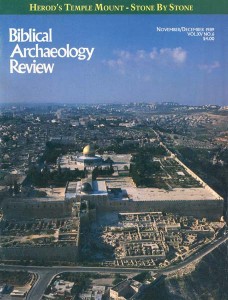Quarrying and Transporting Stones for Herod’s Temple Mount

Herod’s construction in the Temple Mount area, like the construction of most of Jerusalem’s buildings, used local limestone.
The mountains around Jerusalem are composed of Turonian and Cenomanian limestone that has a characteristic horizontal layering. These horizontal layers vary between about 18 inches and 5 feet thick. In exceptional cases, the layers are even thicker.
To quarry this limestone the stonecutter first straightened the face of the stone. This consisted of chiseling the rock in such a way as to produce a flat vertical surface—the side of the incipient stone—and a flat surface on top. Next, with a pickax he dug narrow channels 4 to 6 inches wide on all sides except the bottom of the incipient stone. In two of these grooves, at right angles, the quarryman would insert dry wooden beams, hammer them tightly into place and pour water over them. This caused the wood to swell, and the consequent pressure caused the stone to separate from the lower rock layer.
Already a library member? Log in here.
Institution user? Log in with your IP address.

